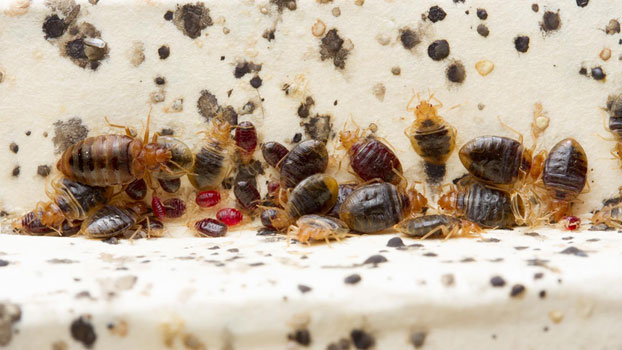A1 Bed Bug Exterminator Houston: Reputable Treatment Solutions
A1 Bed Bug Exterminator Houston: Reputable Treatment Solutions
Blog Article
Understanding the Lifecycle of Pests for Targeted Control Techniques
Recognizing the lifecycle of bugs is a fundamental element of effective bug monitoring techniques. Through a deeper understanding of how bugs flourish and advance, tailored control strategies can be made to deal with details factors in their lifecycle, ultimately leading to even more effective insect monitoring end results.
Relevance of Comprehending Bug Lifecycle
Comprehending the lifecycle of parasites is crucial for establishing effective and targeted control strategies in bug management. By understanding the different phases an insect goes via from egg to adult, bug control experts can identify at risk factors in the lifecycle where treatment can be most successful.
Moreover, recognizing the specific ecological problems needed for each stage of the insect's lifecycle can direct decisions on environment adjustment or exemption techniques to minimize and interrupt the lifecycle bug populations. This understanding enables pest administration professionals to implement aggressive procedures instead than relying only on reactive treatments, leading to even more long-lasting and lasting bug control solutions. Ultimately, a detailed understanding of bug lifecycles equips pest control practitioners to tailor their methods efficiently, maximizing and decreasing ecological impacts control end results.
Secret Stages in Pest Growth
To successfully carry out targeted control methods in bug monitoring, an important facet hinges on adequately determining and recognizing the key stages in bug growth. Pest development normally is composed of several essential stages that are vital for their lifecycle and monitoring. The initial stage is the egg stage, where pests lay eggs that later hatch into larvae. Larvae then advance right into pupae, a phase where they undertake transformation prior to emerging as adult pests. Comprehending these stages is necessary as it aids in pinpointing prone factors in the lifecycle where control measures can be most effective.

Susceptabilities in Bug Lifecycle
Throughout the numerous phases of an insect's lifecycle, distinctive vulnerabilities emerge that can be purposefully targeted for efficient control actions. One critical susceptability lies in the egg phase, where pests are commonly a lot more at risk to certain insecticides or biological control agents due to their soft external shell, making them easier targets for treatment. Furthermore, the larval or nymph stage offers susceptabilities as pests undergo fast development and development, needing high power consumption that can be made use of by interrupting their food resources or introducing growth preventions. Pupal phases, characterized by immobility and improvement, supply a window for targeted control with physical obstacles or details treatments that hinder successful introduction. Finally, adult insects, while extra resistant as a result of their reproductive ability, can still be vulnerable during mating or egg-laying activities, which can be disrupted with scent catches or sanitation strategies. Recognizing these vulnerabilities in the pest lifecycle is crucial for developing exact and reliable control approaches that properly take care of parasite populaces while minimizing environmental effect.
Implementing Targeted Control Steps

Implementing targeted control measures generally involves a multi-faceted approach. This might include habitat alteration to make the setting much less congenial to pests, such as getting rid of standing water for insect control or securing access factors for rats. Additionally, organic control techniques can be used, where natural predators or pathogens are presented to keep parasite populaces in check.
Chemical control, such as the careful application of pesticides, is one more usual approach. It is important to make use of these materials deliberately to minimize environmental effect and possible damage to non-target types - A1 bed bug extermination houston. Integrated Parasite Management (IPM) techniques that combine different control steps in a coordinated and lasting manner are frequently the most efficient in accomplishing lasting parasite monitoring objectives. By applying targeted control actions based upon a comprehensive understanding of insect lifecycles, insect populations can be efficiently managed while lessening dangers to human wellness and the informative post setting.
Improved Pest Management Practices

Furthermore, the incorporation of organic control agents, such as all-natural killers or microorganisms of pests, can assist reduce dependence on chemical pesticides and advertise a much more well balanced environment. Executing physical obstacles and traps can likewise become part of improved parasite management practices, using safe and targeted options for parasite control. Furthermore, making use of scents and various other semiochemicals can disrupt pest mating patterns and communication, resulting in minimized parasite populations gradually.
Verdict
To conclude, recognizing the lifecycle of pests is critical for effective insect administration strategies. By identifying crucial phases in parasite development and vulnerabilities in their lifecycle, targeted control procedures can be applied to minimize insect populations. Boosted parasite management techniques can help in reducing the reliance on broad-spectrum chemicals and promote even more eco friendly and lasting parasite control techniques. This knowledge plays an important function in maintaining healthy ecological communities and agricultural efficiency.
Comprehending why not try these out the lifecycle of parasites is vital for establishing reliable and targeted control methods in pest monitoring. By comprehending the numerous stages a pest goes with from egg to adult, bug control professionals can determine vulnerable factors in the lifecycle where intervention can be most effective. Ultimately, a thorough understanding of bug lifecycles empowers bug control specialists to customize their techniques efficiently, taking full advantage of and minimizing environmental influences control outcomes.
By carrying out targeted control actions based on an extensive understanding of parasite lifecycles, insect populaces can be efficiently managed while decreasing risks to human health and wellness and the setting.
By recognizing essential stages in parasite growth and vulnerabilities in their lifecycle, targeted control procedures can be applied to minimize insect populaces.
Report this page